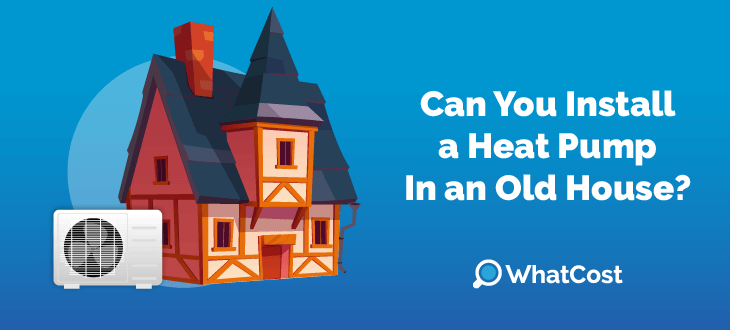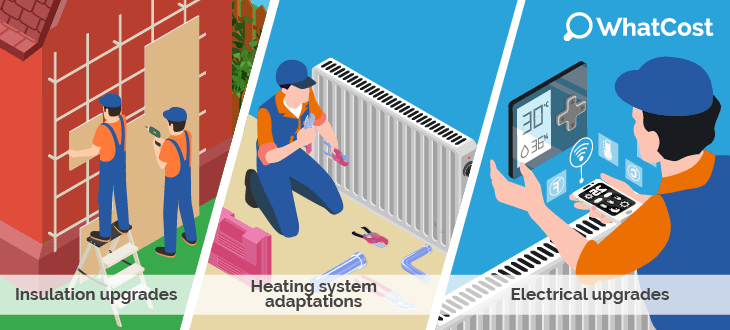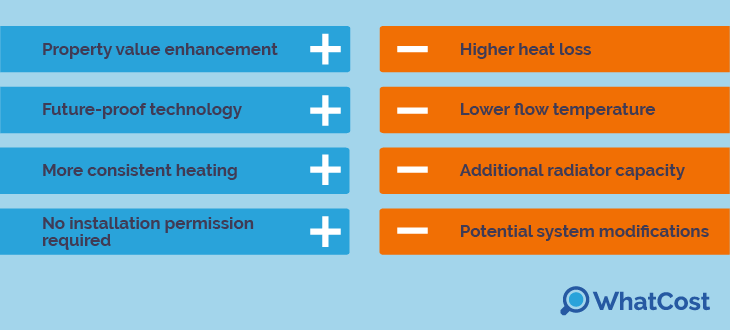Answer these simple questions and we will find you the BEST prices
Which type of solar quotes do you need?
It only takes 30 seconds
100% free with no obligation

Get up to 4 quotes by filling in only 1 quick form

Install a heat pump for less with the BUS grant

Increase the value of your home by installing a heat pump
- whatcost.co.uk
- Heat Pumps
- Air Source Heat Pumps in Old Houses
Air Source Heat Pumps in Old Houses: How Does It Work?


- Installing a heat pump in an older building is possible after certain insulation, heating, and electrical upgrades for the most optimal performance and energy efficiency.
- On average, installing an air source heat pump in an old house costs £8,250–£12,500. However, the system modifications needed for the optimal performance of a heat pump range between £10,900–£36,300.
- By retrofitting your older home with a heat pump, you will enjoy efficient and sustainable heating, energy bill savings and year-round comfort.
Heat pumps are widely regarded as an energy-efficient and cost-saving heating option. In January 2025, the UK heat pump installation saw a 21% increase compared to the same period the previous year, meaning that more homeowners are opting for this modern heating solution. But do heat pumps work in old houses?
Properties built before the mid-20th century typically lack proper insulation and up-to-date heating systems. So, installing any heat pump in a poorly insulated house isn't the best idea. Yet with certain system modifications and smart planning, it has a chance of becoming a worthwhile investment. In this guide, we'll cover all the whats and hows as well as the probable costs.
And just like with any other installation, choosing the right heat pump is challenging without a professional installer. Yet, how long can it take you to find an expert you can trust? You can search for days (if not weeks) before you find one actionable quote in your area.
Instead, you could fill out our 30-second form below and receive up to 4 free, no-hassle heat pump quotes within 48 hours. Click below to get your quotes.
- Quotes from local installers
- Payment by finance available
- Save £7,500 with BUS grant
It only takes 30 seconds

Do heat pumps work in old houses?

Put simply – yes, heat pumps definitely work in old houses. But there's a catch. The effectiveness of their operation depends on the building's specific thermal properties, mainly the level of its insulation and draught protection.
In general, the core principle of heating is balancing heat input with loss, and it applies regardless of the building's age. Therefore, if sized properly, a heat pump can perform effectively, provided the home's heat loss rate is compensated for.
This is when installing heat pumps in old houses requires targeted upgrades because of 3 core challenges:
- High heat loss: Older buildings don't meet modern insulation standards and have draughty floors, doors, and windows (usually single glazed), which altogether elevates the heat loss by 30-50%.
- Electrical constraints: Typically, the total electrical capacity of older properties is limited to 60-100A service, which has trouble supporting the 15–50A draw of heat pumps.
- Lower flow temperature compatibility: Radiators in older buildings were designed to withstand flow temperatures of 70-80℃, while modern heat pumps work best at lower temperatures of 35-55℃. Pairing a modern heat pump with older radiators reduces the output of the latter by 30–40%.
However, field studies and practical applications have shown that many older homes can still achieve sufficient heating with flow temperatures averaging around 44℃, especially if radiators are oversized or after improving insulation.
In cases where radiators are undersized or poorly matched to the lower temperature regime, upgrading to larger or more efficient radiators is necessary to maintain adequate heat output.
Professional heat pump installers can determine whether your radiators are adequately sized by measuring their size (in sq feet or meters) and current heat output (as a rule, in Watts or BTUs – British Thermal Units). They will next compare this data to your heat demand and calculate the heat loss for the heat output needed for your situation.
While the abovementioned issues are significant, installing a heat pump in an old house is possible by carefully addressing them. Let's look at what needs to be modified in more detail.
What upgrades are needed in your old home before installing a heat pump?

Upgrading the energy efficiency of your house is paramount before installing a heat pump, with insulation standing at the forefront of any needed improvements.
| Improvement | Reason | Required changes |
|---|---|---|
| Loft insulation | To reduce heat loss through the roof by 25% | Increase insulation depth by >350mm using sheep's or mineral wool, cellulose, spray foam |
| Wall insulation | To reduce heat loss by 30–40% through solid/cavity walls | Internal or external insulation for solid; insulation foam injections for cavity walls |
| Windows and doors | Minimise draughts by 70% (in single glazed homes) | Add weatherstripping, double or triple window glazing |
| Floor insulation | Reduce heat loss through suspended timber or solid floors by 10-15% | Installation of rigid insulation boards between floorboards or insulation between joists. |
We can't help sounding like a broken record, but insulation is critical for installing a heat pump in an old house. It reduces heat loss and ensures the heat pump operates efficiently at lower flow temperatures.
For optimal moisture management, use breathable materials like sheep's wool, which is also ideal for listed buildings.
Magnetic and fixed acrylic secondary glazing works perfectly for noise and draughts reduction as well as preservation of original windows.
| Improvement | Reason | Required changes |
|---|---|---|
| Radiator upgrades | To adjust the heat output to heat pumps | Replace radiators with larger models or install low-temperature fan-assisted radiators |
| Pipework upgrades | 15mm pipes restrict flow rates needed for heat pumps | Replace with 22mm pipes and install hydraulic balancing valves to optimise flow |
| Underfloor heating (UFH) (optional) | An alternative heat emitter | Install UFH with insulation beneath (>100mm PIR boards) |
The main issue with older radiators is that they don't meet the minimum output needed for efficient heat pump operation. Single panel radiators emit 30–60 W/m² (Watt per sq meter) at 55°C, which is insufficient for heat pumps. Modern Type 22/33 radiators provide 50–100 W/m² at the same temperature.
Another problem is narrow old-time piping (15mm), which interferes with the heat pump's cycle and causes pressure drops. Upgrading to 22mm pipes will reduce the pressure drop by 50–70%.
| Improvement | Reason | Required changes |
|---|---|---|
| Electrical capacity | Older homes can't meet the requirements of modern heating systems | Upgrade to a 200A consumer unit and install a dedicated circuit for the heat pump |
| Smart control | Heat pump efficiency optimisation in houses with uneven heating zones | Smart thermostats and zone valve installation for heating zoning |
| Load management | An alternative heat emitter | Add load-shedding devices |
As mentioned earlier, older homes struggle to keep up with modern energy demands. Heat pumps alone require 15-50A during operation, which means they consume 30–50% of the total capacity. On top of that, running other appliances like electric shower or induction hob at the same time risks overloading circuits or damaging wiring.
This is why upgrading to a 200A electric service, installing a smart load management system, and a dedicated heat pump circuit is necessary when considering a heat pump for your old property.
Cost of air source heat pumps in old houses
On average, air source heat pumps cost around £8,250–£12,500 to install. Considering the upgrades needed, the projected cost to prepare the property for the heat pump installation varies between £10,900 and £36,300.
| Element | Cost |
|---|---|
| Heat pump unit | £8,250–£12,500 |
| Loft insulation | £500–£1,000 |
| Secondary glazing | £160–£1,860/window |
| Cavity wall insulation | £500–£4,000 |
| Floor insulation | £1,000–£5,000 |
| Underfloor heating | £5,000–£15,000 |
| Electrical system upgrades | £1,500–£3,000 |
| Radiator upgrades | £2,000–£6,000 |
| Pipework replacement | £80–£120/linear meter |
| Thermostatic radiator valves (TRVs) | £15–£40 |
| Smart thermostat | £150–£280 |
The bad news: these upgrades are a substantial investment. The good news: a part of the cost can be offset through the Boiler Upgrade Scheme (BUS), which covers £7,500 of the air source heat pump installation. This grant is available for homeowners in England and Wales but has strict insulation requirements due to preservation restrictions.
Moreover, after installation, you can start saving money on your energy bills: £290 yearly (compared to an old gas boiler).
Not every property will need all of the abovementioned modifications. And also, this article doesn't include every possible upgrade needed, otherwise, it would get endless. The fastest way to know which upgrades your particular home needs is to consult a professional heat pump installer.
Yet searching for reputable professionals on your own takes weeks and a lot of patience. And chances are that the engineer you find might be booked months ahead or have no experience with installations at old properties.
Thankfully, we can do the heavy lifting for you. Simply fill in our 30-second form, and we'll provide you with up to 4 quotes from trusted professionals in your area. It's that simple, as well as free of charge and non-binding.
Click below to request your quotes.
- Quotes from local installers
- Payment by finance available
- Save £7,500 with BUS grant
It only takes 30 seconds

Installation process of a heat pump in an old house
Installing a heat pump is not straightforward for older and historic buildings. Depending on the condition of the property and the complexity of the required upgrades, installing an air source heat pump in an old house can take between 3 weeks to several months to complete.
As discussed above, older homes require careful planning and a number of pre-installation steps.
Step 1: Heat loss and heating demand analysis
This step is crucial as older homes are prone to losing heat 2-3 times faster than modern property types. An installer will run an elemental heat loss assessment (required for heat pump grants like BUS) to determine losses through walls, roofs, and windows using U-values. The lower the U-value, the better the insulation.
Here's an example of typical U-values of poorly insulated elements and optimal U-values for heat pump installation and grants eligibility:
| Element | Typical U-values | Optimal U-values |
|---|---|---|
| Walls | 1.5–2.1 W/m²K | 0.18 W/m²K |
| Roofs | 0.8–1.5 W/m²K | 0.13 W/m²K |
| Windows* | 4.8–5.7 W/m²K | 1.4 W/m²K |
Next, the peak heating load is calculated in order to determine the adequate heat pump size. For listed and historic buildings or when physical assessment is not possible, this could be done through thermal imaging.
Step 2: Insulation and heating upgrading
Once the planning is done, preparation works can begin. Wall and loft insulation and secondary glazing works are performed. Listed buildings may require breathable insulation materials like lime plaster to prevent moisture buildup in timber structures.
Radiator and pipework systems are also upgraded at this stage. Radiators are replaced with those with higher output and wider pipes (22mm) are installed to handle lower flow rates.
Oftentimes, the electrical system is upgraded at this point. Older and weaker electrical systems (60–100A) are upgraded to the 200A service to withstand the heat pump's high draws (15–50A during operation).
Step 3: Heat pump installation and testing
To install an air source heat pump in an old house, an old boiler is removed, and a buffer tank (50L per kW of heat pump capacity) is installed for a stable heat distribution. For ground source heat pumps, the installation process involves digging trenches or boreholes for ground loops.
Beware of asbestos insulation when dealing with pre-1980s boilers. Only work with licensed contractors.
An outdoor unit is installed on a wall bracket or a concrete pad ≥1m from boundary walls and should produce <42dB noise at the nearest window. Next, an indoor unit (a hydraulic module) is installed together with thermostatic radiator valves (TRVs) and smart thermostats.
Next, radiator valves are adjusted for the optimal flow rate, and the corresponding flow temperatures are set in radiators. Additionally, the COP (coefficient of performance) is measured using a heat meter.
Pros and cons of a heat pump in an old house

Advantages:
- Property value enhancement: Installing a heat pump in an old house improves the property's energy performance certificate (EPC) due to transitions to a more sustainable heating system. Since energy efficiency is becoming more important in property valuation, period homes with heat pumps can benefit from increased property value as they will offer reduced energy bills and lower emissions.
- Future-proof technology: Heat pumps meet all legal requirements for using renewable energy as a heat source. Therefore, your old dwelling is prepared for future environmental policies, potentially increasing its appeal on the estate market. Additionally, an air source heat pump and solar panels working together enhance the property's long-term value.
- More consistent heating: A ground, water, or air source heat pump in an old house can enhance your living comfort as it resolves the issue of uneven heating and temperature fluctuations. In fact, 73% of homeowners were reportedly "satisfied or more satisfied" with their heat pump compared to their previous heating system.
- No installation permission required: Heat pump installation in an old house is considered a permitted development in the UK, therefore, it doesn't require planning permission. However, if your old house is a listed property, you will need to get a Listed Building Consent so that the installation doesn't interfere with the appearance of your historic building.
When replacing an oil or LPG boiler with a heat pump, older properties can see reduced running costs. Yet replacing a gas boiler with a heat pump might not bring significant savings as gas is the cheapest heating source available.
However, some homeowners saw a £480 energy bill reduction after replacing an old gas boiler with an air source heat pump at their insulated old house.
Disadvantages:
- Higher heat loss: Compared to modern properties, older buildings have outdated insulation, single-glazed windows, and solid walls, which results in greater heat loss. This makes installing a heat pump at an unmodified old property inefficient.
- Lower flow temperature: Heat pumps operate with lower temperatures of 35-50℃ while radiators in old houses were designed to supply water at around 80℃.
- Additional radiator capacity: Because of the lower flow temperatures, traditional radiators emit less heat, which might necessitate bigger or additional units.
- Potential system modifications: Introducing insulation, window, radiator, electrical upgrades, or piping and distribution system adjustments might be necessary to ensure an efficient installation and later use. However, these modifications incur additional spending, which might not fit some budgets.
Should you get a heat pump in your old house?
Installing a heat pump in an old house is a surefire way to transform your home into a comfortable, energy and cost-efficient space. Yet it's not the case for a heat pump in a poorly insulated house and an outdated electric system.
Together with high air source heat pump prices, let alone ground source heat pump cost in the UK, system upgrades required for installation pose significant financial hurdles.
This is why for the most informed decision, you should consider talking to an installer first. They will carefully assess your old home's condition and suggest the structural changes your particular property needs. They will also calculate potential costs and help you apply for a grant if necessary.
Yet to find an installer you can trust, you need to read through countless reviews and call up the contractors to compare their prices. Is it something you would like to spend your valuable free time on?
If not, let WhatCost do the legwork for you. Simply complete our questionnaire, and we'll connect you with up to 4 installers. Compare their free, non-binding quotes and find the one which fits your budget.
Click below to get your quotes.
- Quotes from local installers
- Payment by finance available
- Save £7,500 with BUS grant
It only takes 30 seconds

FAQ
Heat pumps can be a worthwhile investment in old houses, provided such properties have sufficient insulation, new radiators or underfloor heating to ensure the most optimal temperature flow.
Yes, you can absolutely install a heat pump in an old house. Consulting with a heat pump installer and thorough planning are crucial to determine the most suitable system type and any insulation or HVAC upgrades needed.
High temperature heat pumps are suitable for poorly insulated older homes as they can handle higher flow temperatures. However, provided the house has proper insulation, an air or ground source heat pump will suffice as well.
